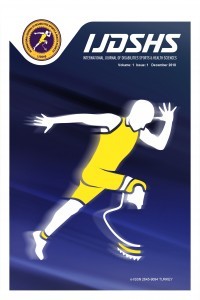Which Cold Application is More Effective for Tennis Elbow? Cooling Gel vs Cold Pack
Which Cold Application is More Effective for Tennis Elbow? Cooling Gel vs Cold Pack
Thermal Analysis, Cold, Epicondylitis Tennis Elbow, Pain,
___
- American Medical Association. Accessed January 8, 2018. https://www.ama-assn.org/.
- American Physiological Society. (2004). Adding Menthol to Topical Creams for Osteoarthritis Provides Significant Pain Relief. https:// www.eurekalert.org/pub_releases/2004-04/aps-amt041104.php.
- Beneliyahu, D. (1992). “Infrared Thermography and the Sports Injury Practice.” Dynamic Chiropractic 10 (7).
- Cerezci Duygu, S., Ozunlu Pekyavas, N., Uzun A., Cinar Medeni, O.,Baltaci, G., Er, F., Suveren, C., & Colakoglu, F.F. (2018). “Muscle Skin Temperature Responses for Hamstring and Quadriceps to Aerobic and Anaerobic Test Conditions in Turkish Olympic Sailing Athletes.” Journal of Thermal Analysis and Calorimetry. https://doi.org/10.1007/s10973-018-7865-8.
- Coben, R., and Padolsky, I. (2008). “Infrared Imaging and Neurofeedback: Initial Reliability and Validity.” Journal of Neurotherapy 11 (3): 3–13. https://doi.org/10. 1080/10874200802126100.
- Downie, W. W., Leatham, P. A., Rhind, V. M., Wright, V., Branco, J. A., & Anderson, J. A. (1978). “Studies with Pain Rating Scales.” Annals of the Rheumatic Diseases 37 (4): 378–81.
- Fedorczyk, J. M. (2006). “Tennis Elbow: Blending Basic Science with Clinical Practice.” Journal of Hand Therapy 19 (2): 146–53. https://doi.org/10.1197/j.jht.2006.02.016.
- Goguin, J. -P., & Rush, Fr. (2003). “Lateral Epicondylitis.What Is It Really?” Current Orthopaedics 17: 386–89. https:// doi.org/ 10. 1016/S0268.
- Hong, Q. N., Durand, M. J., & Loisel, P. (2004). “Treatment of Lateral Epicondylitis: Where Is the Evidence?” Joint Bone Spine 71 (5): 369–73.https://doi.org/10.1016/J.JBSPIN.2003.05. 002.
- Hume, P. A., Reid, D., & Edwards, T. (2006). “Epicondylar Injury in Sport.” Sports Medicine 36 (2): 151–70. https://doi.org/ 10.2165/00007256-200636020-00005.
- Bishai, S. K., & Plancher, K. (2006). The Basic Science of Lateral Epicondylosis: Update for the Future. Techniques in Orthopaedics. Vol. 21.https://doi.org/10.1097/01.bto.0000252115.76643.78.
- Rotsalai, K. and Janwantanakul, P. (2005). “Comparison of Skin Surface Temperature during the Application of Various Cryotherapy Modalities.” Archives of Physical Medicine and Rehabilitation 86 (7): 1411–15.
- Knight, K. L. (1995). Cryotherapy in Sport Injury Management. Human Kinetics.
- Kraushaar, B. S., & Nirschl, R. P. (1999). “Tendinosis of the Elbow (Tennis Elbow). Clinical Features and Findings of Histological, Immunohistochemical, and Electron Microscopy Studies.” The Journal of Bone and Joint Surgery. American Volume 81 (2): 259–78.
- Kraushaar, B. S., & Nirschl, R. P. (1999). “Current Concepts Review Tendinosis of the Elbow (Tennis Elbow).” The Journal of Bone and Joint Surgery 81-A (2): 259–77.
- Lessard, L. A., Scudds, R. A., Amendola, A., & Vaz, M. D. (1997). “The Efficacy of Cryotherapy Following Arthroscopic Knee Surgery.” Journal of Orthopaedic & Sports Physical Therapy 26 (1): 14–22. https://doi.org/10.2519/jospt.1997.26.1.14.
- Loughin, C. A., & Marino, D. J. (2007). “Evaluation of Thermographic Imaging of the Limbs of Healthy Dogs.” American Journal of Veterinary Research 68 (10): 1064–69. https://doi.org/10.2460/ajvr.68.10.1064.
- Beyazova, M., & Kutsal, Y. G. eds. n.d. Fiziksel Tıp ve Rehabilitasyon 1-2. Güneş Tıp Kitapevleri. Accessed February 25, 2019. https://www.guneskitabevi.com/Fiziksel-Tip-ve-Rehabilitasyon-1-2,PR-130.html.
- Stanos, S. P. (2007). “Topical Agents for the Management of Musculoskeletal Pain.” Journal OfPain and Symptom Management 33 (3): 342–55. https://doi.org/10.1016/j .jpainsymman.2006.11.005.
- Tunley, B. V., and Henson, F. M. D. (2004). “Reliability and Repeatability of Thermographic Examination and the Normal Thermographic Image of the Thoracolumbar Region in the Horse.” Equine Veterinary Journal 36 (4): 306–12.
- Uçan, Ö., & Ovayolu, N. (2007). " Non-pharmacological methods used in the control of cancer pain." Journal of Fırat Health Services; 2(4): 123-133.
- Vainer, B. G. (2005). “FPA-Based Infrared Thermography as Applied to the Study of Cutaneous Perspiration and Stimulated Vascular Response in Humans.” Physics in Medicine and
- Biology 50 (23): R63–94. https://doi.org/10.1088/0031-9155/50/23/R01.
- Waseem, M., Nuhmani, S., Ram, C. S., & Sachin, Y. (2012). “Lateral Epicondylitis: A Review of the Literature.” Journal of Back and Musculoskeletal Rehabilitation 25 (2): 131–42.
- Wilson, J. J., & Best, T. M. (2005). “Common Overuse Tendon Problems: A Review and Recommendations for Treatment.” American Family Physician 72 (5): 811–18.
- Yayın Aralığı: Yılda 3 Sayı
- Başlangıç: 2018
- Yayıncı: Nevzat DEMİRCİ
Melis BAĞKUR, Bilge BAŞAKÇI ÇALIK, Tuba YERLİKAYA, Uğur CAVLAK
İrem SÜZEN, Tuba İNCE PARPUCU, Hadi Şaban PARPUCU
Tuba BÜLBÜL, Betül TOSUN, Ezgi DİRGAR
Gülşah ZENGİN, Muhammed Rohat YAZICI, Meral HURİ
Which Cold Application is More Effective for Tennis Elbow? Cooling Gel vs Cold Pack
Nihan ÖZÜNLÜ PEKYAVAŞ, Senay CEREZCİ DUYGU
Kemal ALTUNTAS, Nihan ÖZÜNLÜ PEKYAVAŞ, Oya ÜMİT YEMİŞÇİ, Halime Ceren TEZEREN
Bibliometric Analysis of The Olympic Games and Doping Research
Sevgi Sevi YESILYAPRAK, Halime Ezgi TÜRKSAN, Damla KARABAY
Berkan TORPİL, Zeynep BAHADIR, Güleser GÜNEY YILMAZ, Serkan PEKÇETİN
